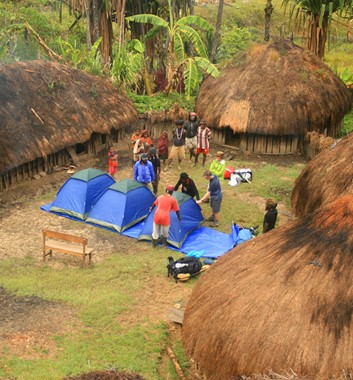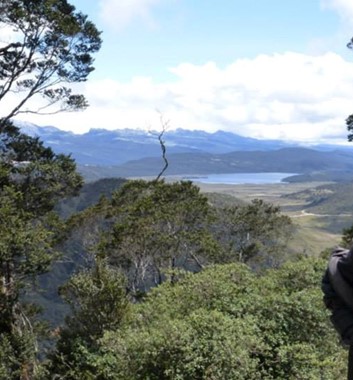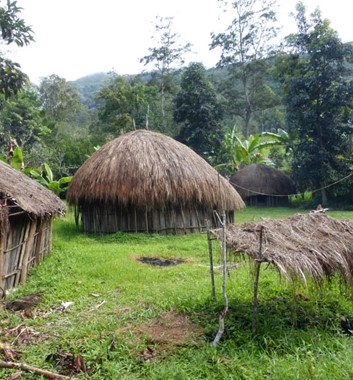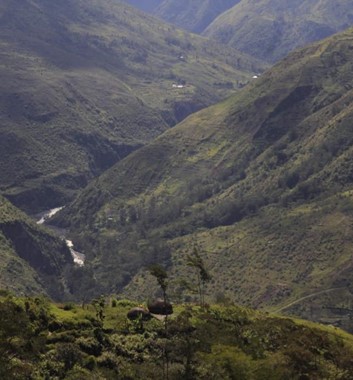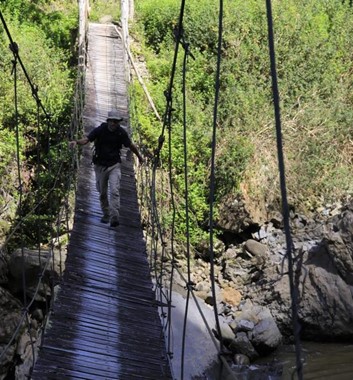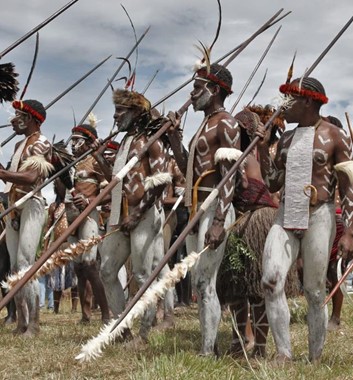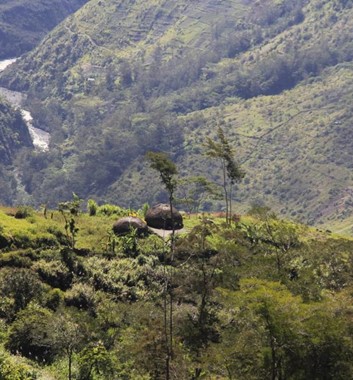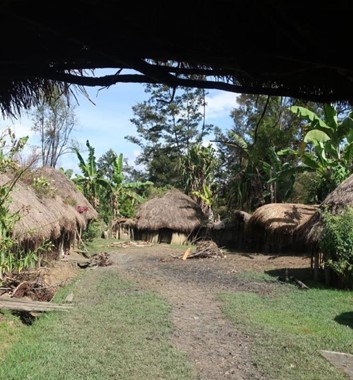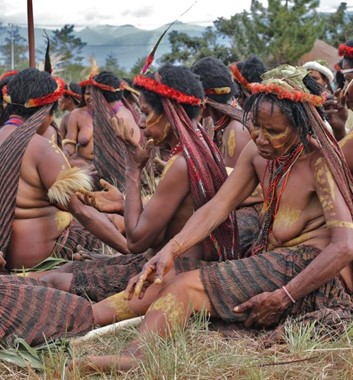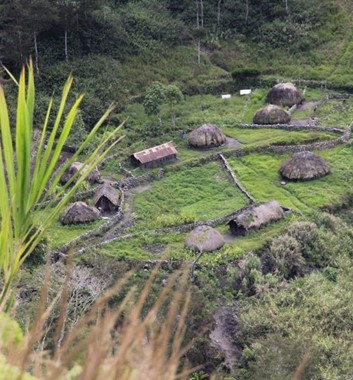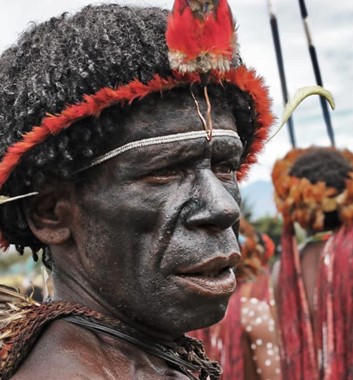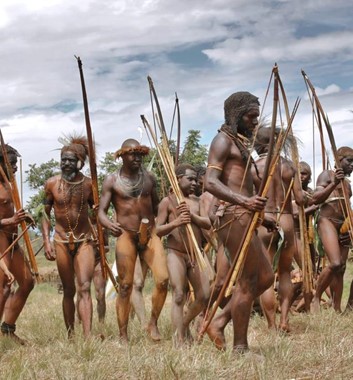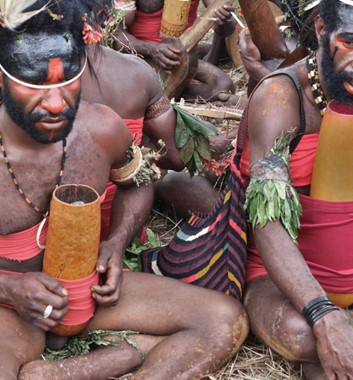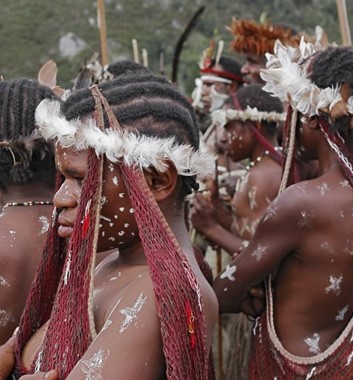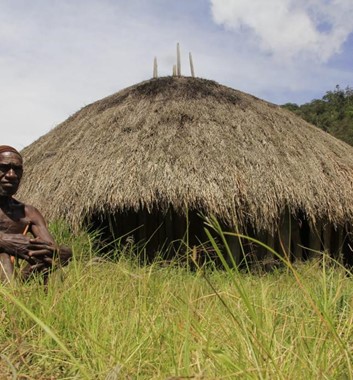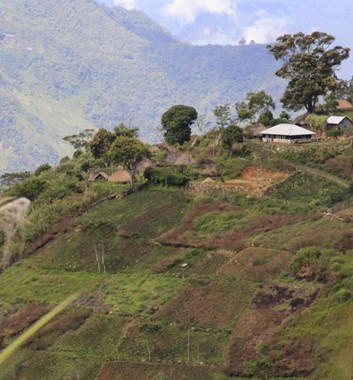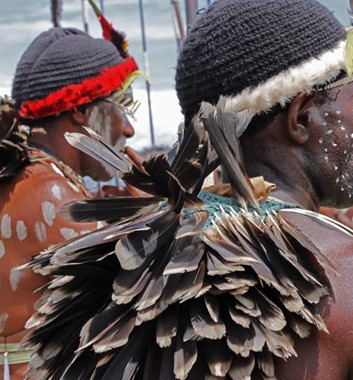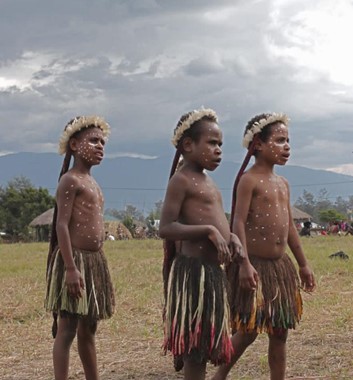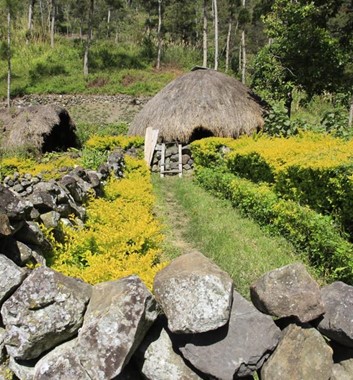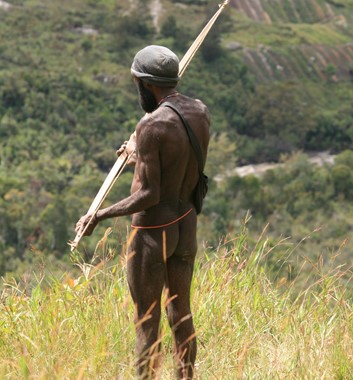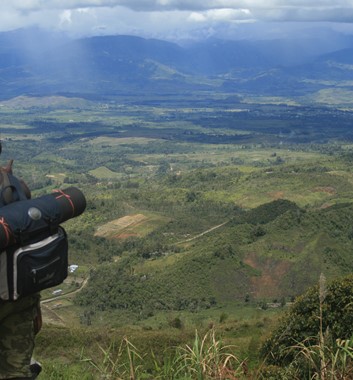Overview
Baliem Valley Festival and trek in Papua
A fascinating week long trek through the remote Baliem Valley in Papua's central highlands, staying in local Dani villages and culminating in a three day visit to the annual Tribal Festival, when all the various highland tribes come together for a mock war and celebration in Wamena – it's a photographers dream and a remarkable experience.
Part of the interest is in the natural environment, but visiting local homes and being immersed in the culture to experience their way of life is equally as fascinating. Communities operate a cohesive social structure that has not been changed by modernity in any way. The trek is very much a step back in time and there is much to learn and respect from the way these tribes still live.
The highlight is the visit to see the Baliem Valley Festival, also known as the pasola festival, when all the diverse tribes from the highlands of Wamena and the Baliem Valley such as the Dani, Lani, and the Yali congregate to celebrate their annual festival. These festivals are held in August, high in the Jayawijaya mountains on the Indonesian side of the island of New Guinea, and includes mock tribal warfare held to maintain the agility and preparedness of the tribes to defend their villages.
These battles are accompanied by Papuan traditional music of Pikon, a musical instrument made out of wood bark which is difficult to play and produces a soothing and melodic sound. Additionally the festival aims to preserve the values and culture of the traditional tribes with art and culture, including traditional dances, pig racing, Puradan Rattan Spear Throwing and Sikoko Spear games.
Papua tribal festival trek itinerary
| Day | 2024 Dates | Summary |
| 1 | 30 July |
Arrive in Jayapura, the capital and largest city of the Indonesian province of Papua. It is situated on the northern coast of New Guinea island The accommodation is in the Hotel Sentani which is a good quality 3 star hotel near the airport. Jayapura is accessible from most far eastern and Australian hubs. Afternoon visit to local market in Sentani and to Bukit to visit the lake. |
| 2 | 31 July |
Internal Flight to Wamena at 1100 which is the 'capital' of Highland Papua. The local hotel is the Pilamo hotel or equivalent. After lunch drive to nearby Napua Hill for a view of the region and stop at a local market in Sinatma and then Jibama. This is an introduction to Dani local life. |
| 3 | 1st August | Another day spent visiting a Dani village, this time for a pig feast and traditional folk dances in Kirulu. Back to the hotel in the evening. |
| 4 - 6 | 2nd to 4th August |
The three day trek follows a number of traditional villages in the Baliem valley and surrounding Kurima district. This will be visiting the mountain people and experiencing life and travel in the Papuan Highlands. Accommodation is either in a local guest house or in tents with local meals provided throughout. Being in the highlands the temperature won't be too hot and there are no worries about mosquitoes. We eventually end up back at Wamena town and the hotel. The trek starts in Kurima, and then climbing the Hesegem hill in the direction of Kilise where accommodation is in a local guesthouse. Total trekking is 3 hours, amongst beautiful green hilly scenery. Then cross the Baliem river and continue to Syokosimo village in about 5 hours the next day. On the third day hike for another 4 hours to Wesangma village. |
| 7 - 9 | 5th to 7th August |
Continue to the Yetni river and drive back to Wamena for the start of the Baliem Valley Tribal Festival in Wusilimo village. Each day is spent watching the spectacle and learning from the guide all about the rituals and events, including archery competition, tribal war performances, traditional dances and music and cooking. All accommodation in the Pilamo. Every day there will be a packed lunch and departure in the morning, arriving back in the late afternoon. A guide will be with the group to explain the meaning of the dances and competitions. Photography is allowed. |
| 10 | 8th August | Internal flight from Wamena to Jayapura at 1230pm, and a visit to the Sentani Lake and the University museum which are local sights. Lunch at Yougwa restaurant, visit some souvenir shops and overnight in the Sentani hotel. |
| 11 | 9th August |
Depart Jayapura or stay in the area. Another option would be to stay and climb Mount Trikora, see below for more details. |
Travel in the Baliem Valley
The Baliem Valley sits in the centre of the Indonesian half of the island of New Guinea. The valley is walled in on both sides by the high mountain ridges of the Sudirman, Maoke, Star and Jayawijaya ranges. The valley its self is at an altitude of between 1600-1700m with its surrounding peaks rising to over 4000m.
As a consequence of its geography the valley was not know to the outside world until 1938 when a reconnaisance flight from a zoological expedition flew over it. Even to this day the only practical way to access the valley is by flying to the airstrip of Wamena. Prior to the 1940's the communities of the valley lived in a way that had changed little since the stone age, including using polished stone for blades and axes.
There are three main tribal groups living in the valley; the Yali, the Dani and the Lani. Each tribe has its own distinct language and cultural practices. All do share some common practices, one of the more famous being the penis-gourd or Koteka, worn by most of the men of the tribes. Many of the men will little else, other than perhaps a wooly hat!
Inevitably, with different tribal groups all occupying a single 'walled' region, there was a long history of some degree of inter-tribal conflict. Legend had it that some tribes would also eat their vanquished enemies. Nowadays the annual Baliem Valley festival plays host to a mock war where the tribes meet and celebrate their own and their shared cultures.
The tribal communities largely live by subsistence farming. They cultivate sweet potatoes, sago palm and taros, a broad-leafed plant that is mainly grown for its root tuber or 'corm'.
Raising pigs is also another essential part of the local food supply. Pig feasts therefore form a very significant part of the cultural rituals of the area such as celebrations. Pigs also usually form the dowry given by the prospective groom to his bride-groom's family. Social superiority is also inevitably measured in part by the number of pigs a family own.
The cultural rituals of the local communities have evolved over millenia and most of the practices can be traced to the essential aspects of survival in a remote and isolated region. One example is the taboo associated with sex for a woman within 2-5 years following giving birth. This would ensure that each child received undivided attention through their most vulnerable early years.
Local village houses are made from the natural materials available to them. The Dani build oval-shaped huts with a framework of wood in-filled with straw and heavy thatching to keep out the rain. Open fires are used cor cooking and also to keep out the mosquitos.
The best time to visit the Baliem Valley in terms of weather is the season from March til September. This will ensure that you miss the worst of the regions high rainfall. However, even during this time the global location and local geography make it inevitable that there will be some rain and possible disruption to the internal flight to and from Jayapura.
Papua travel facts
Flights
When flying to West Papua on the island of New Guinea your international flight will arrive at Sentani Airport near to Jayapura City; (Bandar Udara Sentani) (IATA: DJJ, ICAO: WAJJ). The most economic way to fly to Jayapura (Sentani) is often to buy two seperate tickets; a return to Jakarta and a return from Jakarta to Jayapura.
Visa
British nationals need a visa to enter Indonesia. You can get a 30-day visa on arrival. The UK FCO advise that entry requirements can change at any time, so you should get the latest information from the Indonesian Embassy in London before you travel and talk to us about helping you with the relevant permissions. It is recommended that you carry your passport with you at all times when travelling around Papua.
Vaccinations and Travel Health
You will need to visit your GP well in advance of your trip to discuss vaccinations; we recommend asking about; Primary courses and boosters: diphtheria; tetanus; hepatitis A; typhoid. Also consider: hepatitis B; Japanese encephalitis; cholera.
A yellow fever vaccination certificate is required from travellers over 1 year of age coming from areas with risk of yellow fever transmission.
Insurance
We encourage people to buy insurance as soon as you have booked your flight and trip, in case there is a need for cancellation. Do also take your papers with you and make sure your team mates and group leader know where it is, in case somebody else needs to make a phone call for you.
Papua books and maps
Region Guides
New Guinea: Irian Jaya, Periplus Editions, Eiseman Jr Fred, ISBN-13: 978-0945971061
New Guinea: An Island Apart, Neil Nightingale, BBC Books, ISBN-13: 978-0563361619
Indonesia, Ryan ver Berkmoes, Lonely Planet Publications, ISBN-13: 978-1741048308
Link to free Papua visitor’s guide and map
NY Times articles
Maps
Papua New Guinea, Hema Maps International, 1:2 167 000, ISBN-10: 1875610014, ISBN-13: 978-1875610013
Indonesia - Papua, Maluku, 1:1500 000, Nelles Travel Map, ISBN: 9783865740458
Climbing, Exploration and Rainforest
Descent into Chaos: Doomed Expedition to Low's Gully, Connaughton, Brassey's, ISBN-10: 1857531477, ISBN-13: 978-1857531473
Into the Heart of Borneo, O'Hanlon, Penguin, ISBN-10: 0140073973
Mount Trikora
This is an optional addition to the trip for people who want to explore this interesting peak which is quite challenging to ascend. The price per person is in the region of USD$5000.00 but does depend on the number in the group.
Trikora is an 8 day trip in total, Jayapura to Jayapura.
Day 1: Drive to Lake Habbema (3200m). The savannah-like landscape of the Baliem Valley gives way to fantastic mountain rainforests with monstrous tree ferns and screw pines, covered with moss, lichens and climbing plants. Trek and camp in a suitable place.
Day 2: Hike all day through pristine valleys full of tree ferns until Somalak Cave to set up camp.
Day 3: Hike and set up base camp at about 4100 meters. From here spectacular views over large parts of the central highlands.
Day 4: Summit of Trikora. Dawn start, beginning with a steep wall and followed by a long but relatively easy scramble to the top. The whole day is 10 -12 hours.
Day 5 to 7 : Hike back to Lake Habbema and return to Wamena.
Day 8: Fly to Jayapura.
Puncak Trikora was until 1963, known as Wilhelmina Peak, Puncak meaning Peak. It’s exact height has been of some debate over the years but the accepted height of the summit is 4750m. Perhaps one of the factors in this debate is the fact that it is the third highest peak on the continent of Oceania, only just behind Puncak Jaya (4884m) and Puncak mandala (4760m).
The name Trikora was chosen in 1063 to commemorate a speech by the first president of Indonesia, Kusno “Sukarno” Sosrodihardjo. The speech is known as the Trikora, Tri Komando Rakyat, or "People’s Triple Command". The command being: to defeat the formation of an independent state of West Papua, raise the Indonesian flag in that country, and be ready for mobilization at any time.
The local Dani people who live near Lake Habbema at the foot of the mountain call it Ettiakup. Trikora sits in the Maoke/Jayawijaya Range which forms part of the mountainous the spine of New Guinea, running East-West across the island.
Despite being in the tropics the peak does occasionally receive a blanket of snow on the summit. At the time of its first recorded ascent in 1913 the upper regions still hosted a permanent ice cap. From around 1936 the ice cap was observed to be in retreat and around 1962 it had disappeared altogether.
The vegetation on an ascent of Trikora ranges as you ascend. We find mountain rain-forest then scrub beech trees, grassy swamp, tree-ferns then alpine scrub to lichen-covered scree then bare rock on the summit.
Dates & Bookings
Cost
Papua tribal festival and trek cost £2495.00
INCLUDES
- Accommodation in Jayapura Sentani Hotel
- Internal flight to and from Wamena
- Accommodation in Wamena Grand Baliem hotel, bed and breakfast
- All accommodation in tents or local guesthouse and meals on trek
- Trip Leader and porters
- Papua internal travel permit
- Entrance fee for the festival and expenses for the Dani village visits
EXCLUDES
- International air fare from/to Jayapura
- Indonesia Visa
- Personal Travel Insurance
- Vaccinations
- Evening meals in Jayapura & Wamena
- Photos during the walking tour only (photos at the festival and pig feast are included)
**Please speak to us to confirm that we have the minimum required group size before you book any flights.
Payments
A deposit of £250 is required on booking to secure your place and we ask that the remaining balance (trip price minus the deposit) is paid in full 6 weeks prior to your departure.
Photos
Choose a scheduled date or contact us to set up private dates or a bespoke itinerary. The minimum deposit is £100.00 and the balance is due four weeks before travel.
- Airport Jayapura
- Accommodation Hotel, guesthouse, tent
- Trekking Easy/moderate
- Guide English speaking
- Internal flight Jayapura - Wamena
- Photography Stills and video allowed
- Extras Mount Trikora or diving in Raja Ampat



